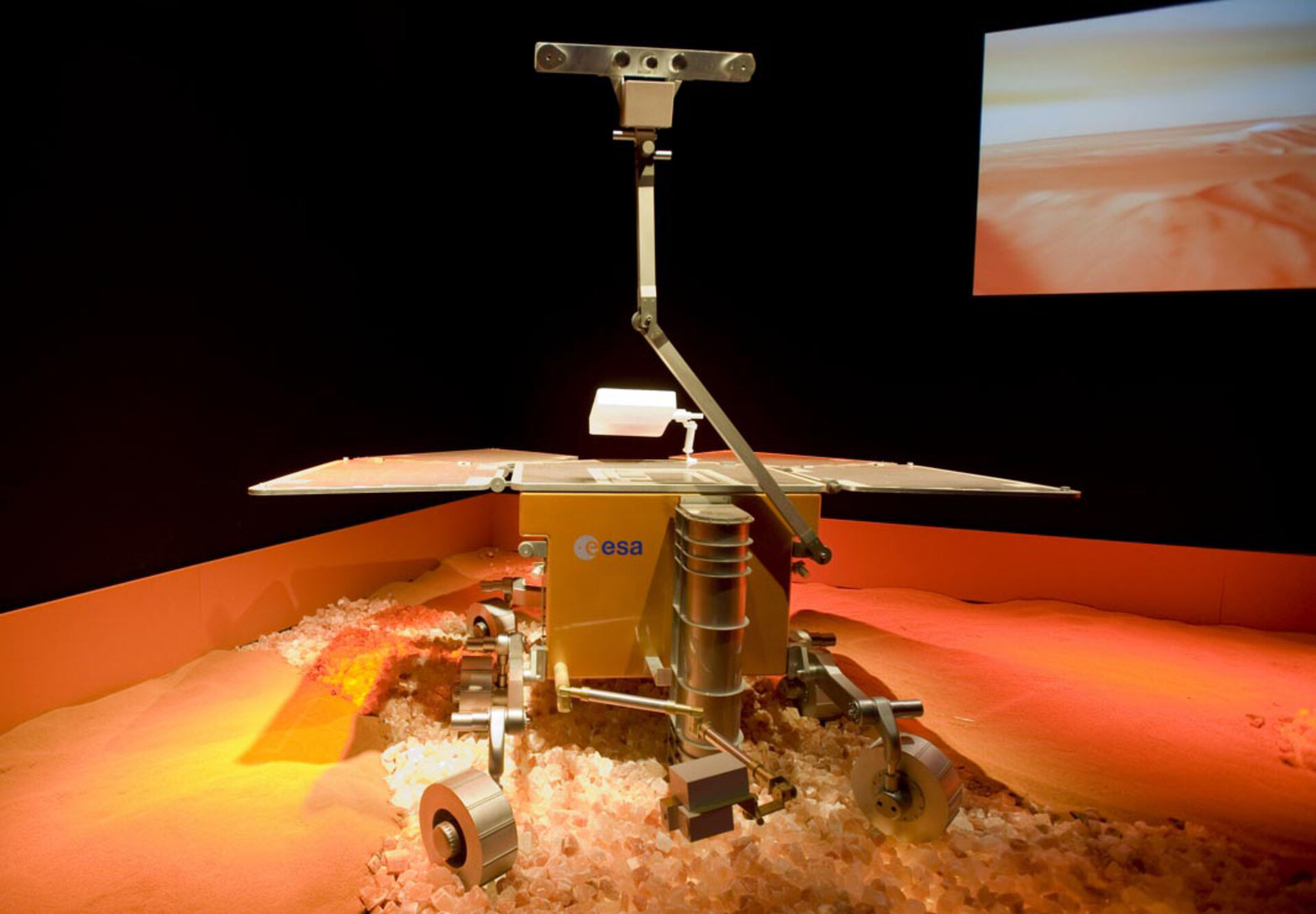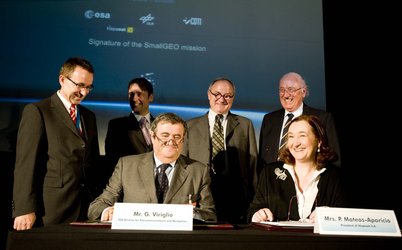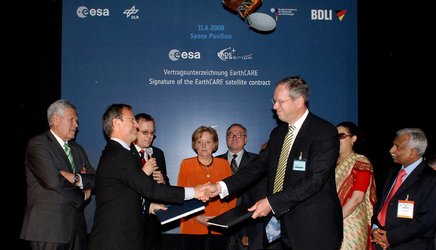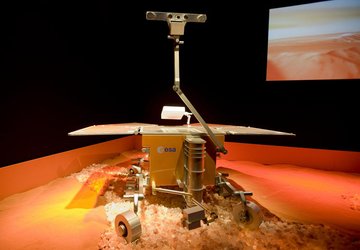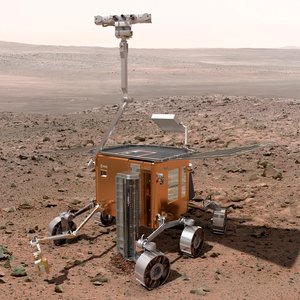‘Space for Europe, Space for the Earth’ at the Berlin Air and Space Show, ILA 2008
The Berlin Air and Space Show, ILA, one of the world’s largest aerospace trade shows, opens today. Organised every two years by the German Aerospace Industries Association (BDLI), this year it takes place in Berlin Schönefeld airport from 27 May to 1 June.
Space, Earth, Life and Europe are the keywords of a special Space Pavilion organised jointly by ESA, the German Aerospace Centre, DLR and BDLI, within the International Space Village in Hall 9, where visitors can learn more about European space programmes and the role played by Germany in space activities.
“With our presence at ILA this year”, explains Fernando Doblas, Head of the ESA Communication Department, “we aim to emphasise the increasing importance of space systems and applications in the daily life of European enterprises and citizens. We show the essential role of space as a source of inspiration, innovation and knowledge, the symbol of the progress, its strategic importance for Europe’s economic growth and employment, for its security and to reinforce its position in a fast-changing world. Following the adoption of the European Space Policy in May 2007 by the ministers of the 29 countries of the European Union and ESA, space is becoming an enabling tool key for European policies, such as environment, security and transport, providing European countries with the ability to respond to critical global challenges, including climate change and security”.

These are some of the topical issues which the Ministers of ESA’s Member States will tackle in November 2008 in The Hague. They will meet to approve space programmes for the future, taking the political decisions necessary in order to consolidate Europe’s role as a leading and reliable global player.
In the space pavilion, particular accent is given to European achievements, including the recent assembly of key European elements to the International Space Station and highlighting the programmes for which political decisions are expected in November, for the future of Europe.
“This explains why we focus this year on our changing planet, on human spaceflight and on future plans to explore Mars and the Moon”, describes Maria Menendez, responsible for ESA exhibitions. “Space for the Earth is the core of the exhibition. The pavilion includes different space dedicated rooms: one for the observation of the Earth; one for the exploration of the Solar System and the Universe; another for advanced studies in telecommunications and for the European navigation system, Galileo; and one for launchers. In order to discover these dedicated areas, visitors leave each room connected by a central area dedicated to the Earth. With a diameter of 12 metres, this will be one of the most impressive attractions of the pavilion that aims to underline how our modern life is increasingly dependent on services that rely on space-based technologies”.
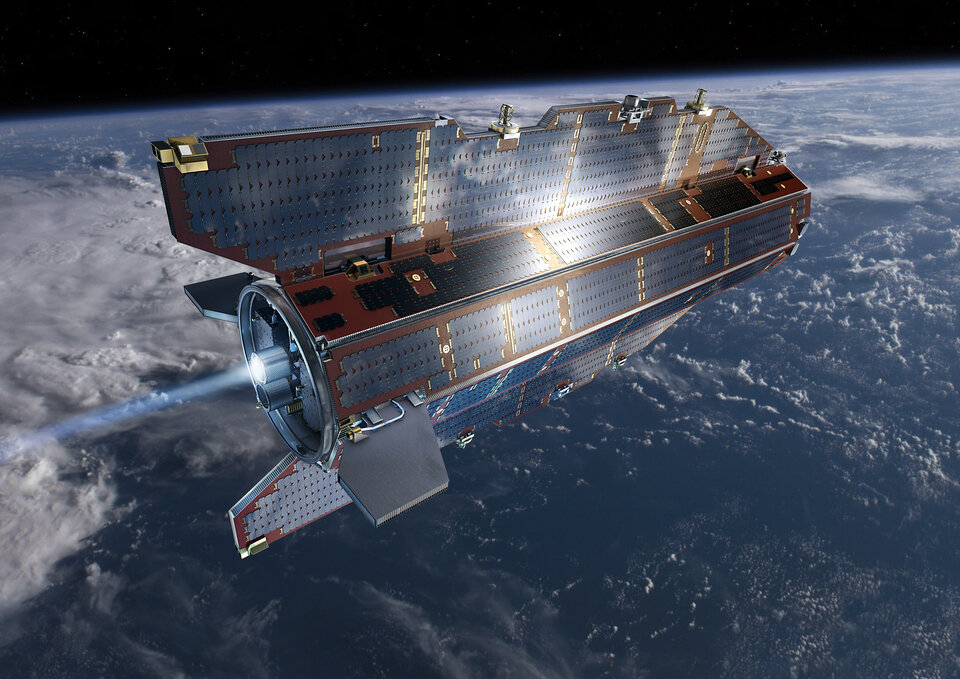
The exhibits dedicated to programmes for observing the Earth underline two major challenges of our time such as climate and global change, explaining to the public the leading role played by European satellites in understanding weather and our environment. The displays on upcoming missions will highlight Sentinel-1 and Sentinel-2, two of a series of satellites of the EU-led initiative GMES, Global Monitoring for Environment and Security. They also show GOCE, the first of the Earth Explorer missions which will bring a whole new level of understanding of one of the Earth's most fundamental forces of nature – the gravity field; and MTG, Meteosat Third Generation, that will dramatically improve data and images for European forecasters and researchers.
Satellites play a vital part in communication networks, helping to improve the quality of daily life. In the pavilion visitors learn more about future projects in telecommunications such as the Small GEO satellite and mission and Alphasat with the Alphabus Large Platform that will allow European industry and operators to offer reliable solutions to match future demands for the global satellite market, a key for Europe’s competitiveness.

2008 marks a fundamental milestone for human spaceflight in Europe: in February, the European space laboratory Columbus was successfully transported to the International Space Station, ISS, and brought into operational service; in March, the ATV European supply vehicle was launched by Ariane 5 and docked fully automatically with the ISS.
These newly tested advanced technologies will give ESA the know-how to prepare future missions further into the Solar System. Europe now has a permanent base in orbit around the Earth where scientists can carry out research and experiments. The public at ILA have an exciting opportunity to visit a full-scale model of the Columbus module and to learn more about how it is controlled from the ground.
Touring the pavilion, visitors can discover long-term ambitious European plans for robotic and human exploration of the Solar System, with the Moon and Mars as the main target destinations. An impressive film of ESA’s Mars Express satellite images allows the public to experience a 3-D virtual flight on Mars, full of realism, walking over the mysterious surface of the red planet.
Looking to the future, they can see a life-size model of ESA’s ExoMars rover, scheduled to land on the red planet in 2013. It will be the first European mission to deploy a rover on Mars to search for signs of life, past or present. The EXOMArs DEmonstration Rover (EXOMADER) an engineering model developed by ESA to evaluate and demonstrate extremely advanced cross-country ability, is also on display.

The exhibition also includes an overview of European launchers with the heavy-lift Ariane 5 and Vega and Soyuz, soon to be launched from Europe’s Spaceport in French Guiana. This family of launchers will guarantee Europe an affordable and independent access to space in the long term.
The public can also learn about the latest results of ESA’s Solar System missions with impressive images of Mars and the Moon and a model of BepiColombo, the future mission to explore Mercury. Using an interactive ‘magic book’ visitors can travel through planets and moons to understand if life can exist on other worlds, and can enter our mysterious Universe to find out more about its secrets, in particular via two ESA pioneer astronomy missions, Herschel and Planck, to be launched later this year.
The space pavilion at ILA is open from Tuesday 27 to Sunday 1 June, with trade days 27-29 May, and open to the general public from 30 May. Throughout the week, a conference centre attached to the space pavilion will host a number of presentations and events.
For further information, please contact:
Maria Menendez
Head of Exhibition Office
Communication and Knowledge Department
Tel.: + 33 1 5369 7167
e-mail: Maria.Menendez@esa.int
Wendy Slater
Exhibitions Office
Communication and Knowledge Department
Tel.: + 33 1 5369 7418
e-mail: Wendy.Slater@esa.int
Annie Sorlin
Epsec, Exhibition Assistant
Communication and Knowledge Department
Tel.: + 33 1 5369 7590
e-mail: Annie.Sorlin@esa.int


